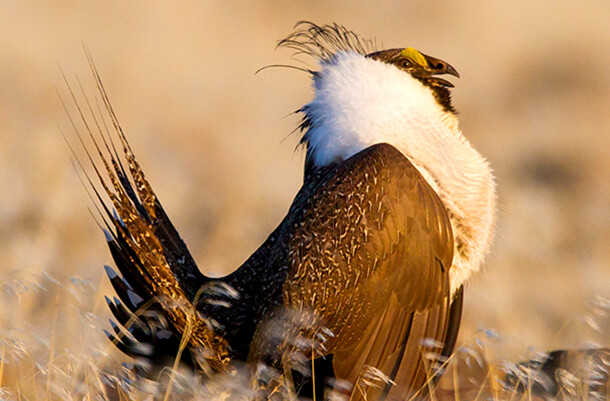House Defense Bill Threatens Endangered Species Act, Sage Grouse and Prairie Chickens

Greater Sage-Grouse, one of two bird species targeted by the House Defense bill. Photo by Vivek Khanzode
Contact: Steve Holmer (sholmer@abcbirds.org), Vice President of Policy, American Bird Conservancy, 202-888-7490
(May 23, 2018, Washington, D.C.) Provisions unrelated to national defense included in the National Defense Authorization Act, H.R. 5515, pose a grave threat to two bird species: Greater Sage-Grouse and Lesser Prairie-Chicken. Both have suffered severe population declines and loss and degradation of their habitats.
"We urge U.S. Representatives to oppose the grouse and prairie chicken rider," said Steve Holmer of American Bird Conservancy. "This provision has nothing to do with national defense, will place imperiled species on the path to extinction, and should be stricken."
Both species' small, disjointed populations face ongoing habitat loss and degradation. The grouse population has plummeted from an estimated 15 million prior to European settlement to fewer than 300,000 today. The U.S. Fish and Wildlife Service is currently reviewing the status for Lesser Prairie-Chicken, which occupies less than 15 percent of its former range and experienced a population drop of 50 percent between 2012 and 2013.
“Endangered Species Act protection provides an essential backstop to hedge against species extinction, particularly in light of major increases in oil and gas drilling in priority grouse habitats in Wyoming, Utah, Idaho, Montana, and Colorado," said Holmer. "Conservation measures and plans that were the basis for finding the listing of Greater Sage-Grouse under the Endangered Species Act (ESA) ‘not warranted' in 2015 have already been, or are in the process of, being weakened or eliminated.”
American Bird Conservancy concluded that while the 2015 management plans were a significant step forward for grouse conservation, additional safeguards were needed. These protections include mitigation of development impacts and adaptive management responses if the population severely declines. Now, internal agency directives have weakened these essential safeguards. The revised plans in Idaho and Utah intend to go even further to reduce mitigation requirements.
One part of the defense bill, Sec. 314, would also block ESA protections for the imperiled Lesser Prairie-Chicken for at least 10 years, in complete disregard for the species' biological status. ESA protection is likely already warranted for the Lesser Prairie-Chicken, and this interference with the science-based listing process is creating a real risk of extinction.
“Potentially the most devastating provision is the one that precludes judicial review of these listing moratoria, which prevents the public from seeking protection for these species even if they are on the very brink of extinction,” said Holmer.
#####
American Bird Conservancy is dedicated to conserving birds and their habitats throughout the Americas. With an emphasis on achieving results and working in partnership, we take on the greatest problems facing birds today, innovating and building on rapid advancements in science to halt extinctions, protect habitats, eliminate threats and build capacity for bird conservation.


















































